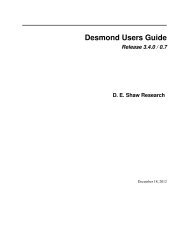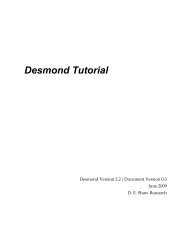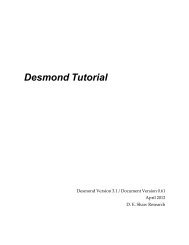Desmond Tutorial
Desmond Tutorial - DE Shaw Research
Desmond Tutorial - DE Shaw Research
- No tags were found...
Create successful ePaper yourself
Turn your PDF publications into a flip-book with our unique Google optimized e-Paper software.
<strong>Desmond</strong> <strong>Tutorial</strong><br />
<strong>Desmond</strong> <strong>Tutorial</strong><br />
Figure 1.9 Protein Preparation Wizard — Selection display<br />
The yellow<br />
dotted line<br />
shows the<br />
hydrogen<br />
bond.<br />
The selected<br />
water molecule<br />
is shown with<br />
a red oxygen<br />
atom.<br />
The selected<br />
item appears<br />
as a yellow<br />
line in the<br />
Workspace.<br />
12. The Generate HET States button is used to automatically generate alternative protonation<br />
and tautomerization states for the HET groups. This is especially useful when<br />
ligands or cofactors are present in the system, but the current example does not have<br />
any such items.<br />
You will need a license from Schrödinger, LLC to use their Epik tool to perform<br />
automatic HET state generation. If you do not have an Epik license, you will have to<br />
prepare your ligands and cofactors outside the Maestro environment before you<br />
import the system into Maestro and process it with the Protein Preparation Wizard.<br />
13. At this point you should have a topologically correct molecular system in the Workspace,<br />
which can be subjected to molecular mechanics calculations. However, since<br />
hydrogen atoms were added by the Protein Preparation Wizard using simple geometric<br />
templates, the hydrogen bond network should be optimized.<br />
There are two alternatives in the H-bond Assignment subpanel:<br />
— The Optimize button launches a comprehensive Monte Carlo search: different<br />
protonation states of ASN, GLN, and HIS residues are sampled and OH bonds<br />
are flipped to optimize hydrogen bond geometry. As part of this procedure you<br />
can switch to exhaustive search mode, as well as decide whether the orientation<br />
of crystal water molecules should be sampled.<br />
— The Interactive Optimizer button launches an interactive tool for hydrogen bond<br />
geometry optimization. The interactive optimizer window is shown in<br />
Figure 1.10.<br />
When you click the Analyze Network button, the Protein Preparation Wizard fills in<br />
the table with the current protonation states of ASN, GLN, and HIS residues as well<br />
as initial OH bond orientations. The table on Figure 1.10 reflects the current state<br />
after clicking the Optimize option.<br />
10 D. E. Shaw Research September 2008






